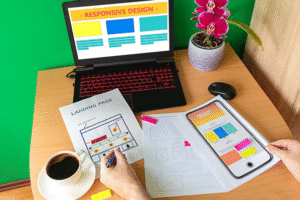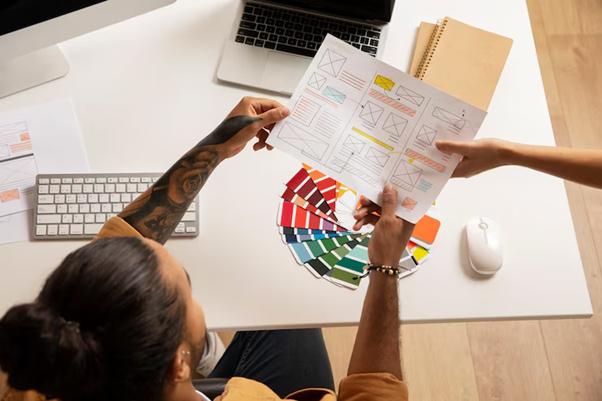The most important part of web design is visual hierarchy. It is a technique that guides the user’s perspective. When a band launches a website, it should tell the community what it looks for first. This is where visual classification comes into play. It determines what is important and what needs to be looked at later. If the hierarchy is not correct in the design, the user gets confused, and the page crashes. Due to which the purpose of the website could not be achieved. A good visual classification saves the user time. This allows the substance abuser to easily sympathise with where the buttons are, what the gallery says, and what the stream of the content is. Effectual design is essential in today’s fast-paced digital landscape. It is not only to show the real face, but also to provide understanding to the user. Visual hierarchy is the soul of design. It prompts easy and direct navigation, which saves the user from delay.

User Focus
The first impact of visual hierarchy classification is in the hands of the user. When something is made bold, bold or colorful, it is the first thing the user’s eye catches. This is naturally occurring. The designer guides the user through the technique. A strong headline, bright CTA button, or bold image guides the user. Achi hierarchy makes the user journey smooth from start to finish. If everything is equal in design, the user doesn’t know what to look for first. He is worried to see this face. If the first impression is unclear, the user continues to browse the page. So it is important to have a place that engages the user. When everything is relevant and well-organized, the visitor’s eye naturally follows.
Ways to improve user attention:
- Use of bright and contrasting colors
- Keep headings in bold and large font
- Highlight icons and images
- Designing CTA buttons in different colors and sizes
- Use consistent spacing and white space
All of these guide the user’s eyes. This method avoids confusion and gives clear direction.
Simplifies Content – Visual Hierarchy
Visual hierarchy categorization makes content easier and more readable. When headings, sub-headings, and paragraphs are well organized, the user can read easily. If everything is as it seems, it seems that he is bored. But if the headline is clear, the content is short, and the line spacing is correct, it’s easy to read. Logos, icons, and images appear in one place so the user knows what topic is being discussed. Such a design arouses the user’s interest. visual hierarchy break points or white space are also important. This keeps the content clean and fresh.
Advantages of Content Readability:
- Fast reading or easy comprehension
- Spend more time on the page.
- Bounce rate should be low.
- The website has a professional feel
- Help with SEO ranking.
An easy and simple layout keeps the user on the page for longer. This means more engagement and better results. From this point of view, every designer should use hierarchy.

Improvement in Conversion Rate
Conversion means taking a user action. Like filling out a form, clicking a button, or buying a product. Visual classification makes the process quick and easy. When the CTA is clear and prominent, the user is more likely to click on it. A call-to-action button becomes more prominent if it’s a bar and colored. If this option is in the middle of the page, the user has seen it first. The white space around the button is also used for highlighting. This is how change happens.
| Component | Visual Effect | The Role of Conversion |
| CTA button | Bright color, large | Attracts the user’s attention. |
| Headline | Bold, top-placed | Introduction to page intent |
| Product image | Clear, focused | Builds user trust. |
| Definitions | Framed, featured | Adds social proof. |
| Sign-up form | At least, the center | Easy to complete. |
Visual classification plays a strong role in most successful websites. This saves the user from confusion and leads them to a simple process. This results in increased business.
Enhances The Mobile Experience with Visual Hierarchy
Nowadays, more and more people use websites on mobile. If the design is not mobile-friendly, it looks difficult. Visual hierarchy makes mobile layout simple and effective. The screen on a mobile is small, so the placement of elements is very important. Text size, button location, and image height are all part of the hierarchy. Headlines are created more frequently in mobile design. Content is scroll able and readable. The CTA button must be within finger reach. The role of visual hierarchy in responsive design is that the user can scroll easily and see everything. If the visual flow is correct, the mobile user experience will be smooth. It also improves Google ranking. Hence, the use of visual classification for mobile becomes even more important.
Branding And Building Trust
Visual classification is not limited to layout. It also helps in building brand image and trust. When a website looks consistent and professional, the user trusts it. If the fonts, colors, and spacing are consistent on every page, the branding is strong. The placement of the logo is on the top left, which improves brand recognition. The tone of the headlines reflects the brand’s voice. The style of the CTA reflects the brand’s personality. When all this happens in one flow, the user’s trust in the website increases. Color scheme and typeface also play an important role in branding. When every element of the website matches the branding, the user has a positive feeling. This makes them trust the product or service. Visual classification organizes this process. It highlights the reputation of the brand. It leaves a good impression on both the business and the product. The result is a strong online identity.

Improves Both UX and UI
Visual hierarchy plays a role in both user experience (UX) and user interface (UI). UX refers to how easy a user finds a website to use. UI stands for the look and feel of the design. When classification is correct, both aspects are improved. User flow has entered society. The goal is to know what needs to be done first and what needs to be done later. Navigation made easy. Elements align properly while scrolling. All this is possible because of classification.
How visual hierarchy improves UX and UI:
- Experience smooth navigation
- Logical and natural content flow
- Designing interactive buttons and forms
- Maintaining design consistency
- highlighting user goals
Button size, color contrast, image positioning all improve UX and UI quality. Better rankings mean lower bounce rates and higher user satisfaction. This is the foundation of a successful website.
Conclusion: Every Designer Should Know Visual Hierarchy
Visual hierarchy is a powerful tool that every web designer should know how to use. It is not only part of the design but also a guide for the user journey. When the design is structured and organized, the user can easily interact. The purpose of each page is to get an action from the user. This is when the layout is clear and attractive. Titles, images, buttons, and content are all in balance. Visual hierarchy maintains balance. If you want your website to convert more, retain more traffic, and build brand value, proper use of visual hierarchy is essential. Applying this principle to every project can make you successful.
